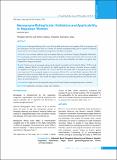Please use this identifier to cite or link to this item:
https://hdl.handle.net/20.500.14356/1425Full metadata record
| DC Field | Value | Language |
|---|---|---|
| dc.contributor.author | Baral, Gehanath | - |
| dc.date.accessioned | 2023-05-10T10:14:58Z | - |
| dc.date.available | 2023-05-10T10:14:58Z | - |
| dc.date.issued | 2019 | - |
| dc.identifier.citation | BaralG. (2019). Menopause Rating Scale: Validation and Applicability in Nepalese Women. Journal of Nepal Health Research Council, 17(01), 9-14. https://doi.org/10.33314/jnhrc.v17i01.1770 | en_US |
| dc.identifier.issn | Print ISSN: 1727-5482; Online ISSN: 1999-6217 | - |
| dc.identifier.uri | http://103.69.126.140:8080/handle/20.500.14356/1425 | - |
| dc.description | Original Article | en_US |
| dc.description.abstract | Abstract Background: Menopausal Rating Scale is one of the globally used tools to assess quality of life in menopause and peri-menopause. The aim of this study is to validate the standard menopausal rating scale in Nepalese menopausal women and to test menopausal symptoms during clinical consultation at hospital. Methods: Cross sectional validation study at Paropakar Maternity and Women’s Hospital, Thapathali, Kathmandu. Five-step language translation of menopausal rating scale from English to Nepali, questionnaire clarity assessment with gynecologists and Likert scale questionnaire based interview to the clients. Reliability and validity tests applied. Each component of rating scale analyzed. Results: Nepali version of menopausal rating scale developed. Acceptable level (Cronbach’s Alpha = 0.77) of tools reliability obtained. Barlett’s test of sphericity was highly significant and Pearson correlation between variables was significant. Average age of menarche was 15 years, and mean and modal value of menopause was 48 and 50 years respectively. First menopausal symptom was vasomotor flush in 62%, one-forth didn’t experience flush, half experienced mild to moderate flush and rest one-fourth had severe to very severe form; 50% had significant sleep, bladder and sexual dysfunction. Three-fourth had vaginal dryness and musculoskeletal problem. One-half had some degree of mental dysfunction. Conclusions: Nepali version of menopausal rating scale developed. Baseline menopausal parameters obtained. Keywords: Applicability; menopause; rating scale; validation. | en_US |
| dc.language.iso | en | en_US |
| dc.publisher | Nepal Health Research Council | en_US |
| dc.relation.ispartofseries | Jan-March, 2019;1770 | - |
| dc.subject | Applicability | en_US |
| dc.subject | Menopause | en_US |
| dc.subject | Rating scale | en_US |
| dc.subject | Validation | en_US |
| dc.title | Menopause Rating Scale: Validation and Applicability in Nepalese Women | en_US |
| dc.type | Journal Article | en_US |
| local.journal.category | Original Article | - |
| Appears in Collections: | Vol. 17 No. 1 Issue 42 Jan - Mar 2019 | |
Files in This Item:
| File | Description | Size | Format | |
|---|---|---|---|---|
| 1770-Article Text-9261-1-10-20190429.pdf | Fulltext Download | 762.06 kB | Adobe PDF |  View/Open |
Items in DSpace are protected by copyright, with all rights reserved, unless otherwise indicated.
